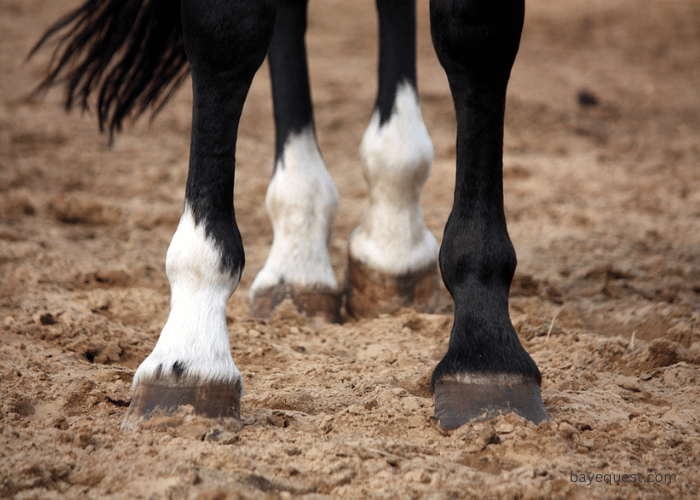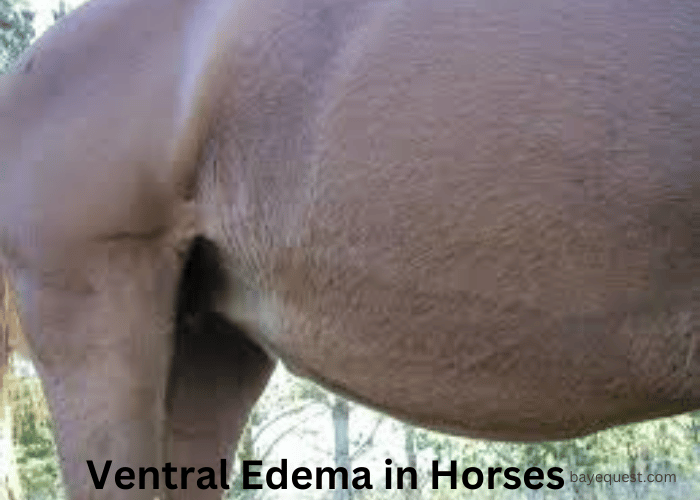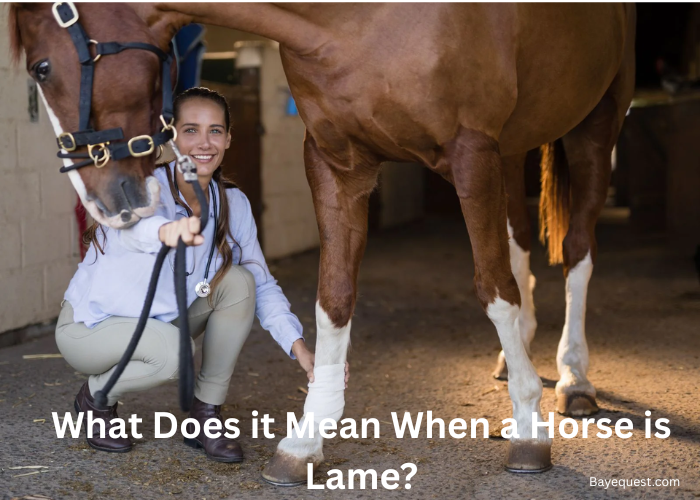Your horse’s belly suddenly looks swollen, and it’s hard to ignore. This could be ventral edema—a fluid buildup that shows up under the skin.
It’s not always serious, but it’s something you’ll want to keep an eye on. From infections to nutrition issues, there are several causes behind this swelling.
Let’s break down what ventral edema in horses is and what it means for a horse’s health.
What is Equine Ventral Edema?
Equine ventral edema is the swelling that occurs under a horse’s belly due to fluid buildup in the tissues. This fluid collects beneath the skin, causing a noticeable puffiness or soft swelling.
Ventral edema can happen for many reasons, including injury, infection, heart or liver issues, nutritional imbalances, or even an allergic reaction.
While it might look alarming, the severity can vary. In some cases, it’s a mild and temporary condition, but it can also signal more serious underlying health problems that need attention.
Common Causes of Ventral Edema
There are several common causes of ventral edema in horses, each with different underlying factors:
1. Infections
Bacterial or viral infections, like cellulitis or an abscess, can cause fluid to accumulate as the body’s immune response fights off the infection. Swelling may appear as the body reacts to inflammation.
2. Heart or liver disease
When a horse’s heart or liver isn’t functioning properly, fluid can build up in different parts of the body, including the belly.
This happens because the heart may struggle to pump blood effectively, or the liver fails to manage fluids properly, leading to edema.
3. Protein deficiency
If a horse has a low protein diet or is unable to properly absorb protein, fluid can leak from the blood vessels and settle under the skin.
This is because proteins help maintain fluid balance in the body, and without enough, fluid shifts into the surrounding tissues.
4. Pregnancy
Pregnant mares may develop ventral edema due to increased pressure in the abdomen as the fetus grows. The weight and changes in circulation can lead to fluid pooling in the lower belly.
5. Allergic reactions
Insect bites, stings, or exposure to allergens can trigger an allergic reaction, leading to localized swelling.
Ventral edema may occur in response to these irritants, especially in warmer months when insects are more active.
6. Inactivity or poor circulation
Horses that stand still for long periods or are confined to stalls can experience poor circulation.
This causes fluid to pool in the lower parts of the body, including the belly, leading to edema.
7. Trauma or injury
A blow or injury to the horse’s abdomen can result in swelling due to localized inflammation and fluid buildup as part of the healing process.
Symptoms of Ventral Edema in Horses
The symptoms of ventral edema in horses are usually quite visible, but the underlying cause may vary. Here are some common signs to look for:
1. Swelling under the belly. The most obvious sign is swelling along the underside of the horse’s belly. This swelling may feel soft and squishy or, in some cases, firmer to the touch.
2. Painless or tender swelling. Ventral edema might not cause the horse any pain, but sometimes the area can become tender, especially if it’s related to an infection or injury.
3. Localized vs generalized swelling. In some cases, the swelling is limited to the belly, while in others, it might extend to other areas like the chest or legs.
4. Skin changes. The skin over the swollen area may look stretched, and in severe cases, it could become irritated or even break open if not treated promptly.
5. Fever or other signs of illness. If ventral edema is caused by an underlying infection or serious health issue, the horse may also show symptoms like fever, lethargy, or loss of appetite.
6. Difficulty moving. Severe swelling may interfere with the horse’s movement, especially if the edema extends to the legs. The horse may appear stiff or uncomfortable when walking.
7. Other accompanying symptoms. Depending on the cause, other symptoms like weight loss, labored breathing, or poor coat condition may accompany the edema.
How Do You Diagnose Equine Ventral Edema?
Diagnosing equine ventral edema involves several steps. Here’s how a vet approaches the diagnosis:
1. Physical examination
The vet will start by visually inspecting the affected area and palpating the swelling.
They’ll assess the size, firmness, and whether the edema is localized to the belly or extending to other parts of the body.
2. Health history
The vet will ask about the horse’s recent activities, diet, health conditions, and any potential injuries or changes in behavior.
This background can help narrow down possible causes, like pregnancy, illness, or recent inactivity.
3. Blood tests
Blood work is often done to check for underlying health issues. The vet will look at markers like protein levels or signs of infection and inflammation.
Abnormal liver or kidney function tests can also point to organ-related causes of the edema.
4. Ultrasound or imaging
An ultrasound or other imaging tests may be used to check for internal issues like fluid accumulation in the abdomen, masses, or organ abnormalities that could be contributing to the edema.
This helps the vet get a clearer picture of what’s happening beneath the surface.
5. Allergy tests
If an allergic reaction is suspected, the vet may suggest allergy testing or skin tests to determine if insects, plants, or other allergens are causing the swelling.
6. Heart and lung examination
If heart or respiratory disease is suspected, the vet will listen to the horse’s heart and lungs for any signs of abnormality.
This could include irregular heartbeats or labored breathing, which may indicate heart disease or other circulatory issues.
7. Fluid analysis
In some cases, the vet may take a sample of the fluid from the swollen area to analyze it. This can help determine if an infection, allergic reaction, or other specific cause is leading to the fluid buildup.
8. Observation and monitoring
If no immediate cause is identified, the vet might recommend monitoring the edema over a few days to see if it worsens or resolves on its own.
Rest and observation can sometimes help clarify whether the edema is a result of mild injury or more serious issues.
Treatment Options for Ventral Edema
Treating ventral edema in horses depends on what’s causing the swelling. Since it’s a symptom rather than a condition, the focus is on addressing the root issue.
Here’s how treatment works:
Rest and monitoring
In mild cases, rest may be all the horse needs. If the edema isn’t causing discomfort and there are no other signs of illness, give the horse time to recover.
Close monitoring is key to ensure the swelling doesn’t worsen or point to a bigger problem.
Treating underlying conditions
If the edema is due to an infection, heart disease, or a nutritional issue, treating that condition is the priority.
You may use antibiotics for infections, while heart or liver problems could require more intensive care.
Also, adjusting the horse’s diet to improve protein levels can help if the edema is related to nutrition.
Anti-inflammatory medications
Anti-inflammatory medications, like NSAIDs, can help reduce the swelling and ease any discomfort the horse is feeling.
While these drugs provide relief, they are to be used alongside other treatments that target the actual cause of the edema.
Cold therapy and bandaging
Applying cold therapy, like cold hosing or ice packs, can reduce inflammation in the swollen area.
In some cases, light bandaging may support the tissues and prevent further fluid buildup. Always consult a vet before using bandages to avoid complications.
Nutritional and hydration adjustments
If poor nutrition is behind the swelling, improving the horse’s diet can help. Adding more high-quality protein or supplements can prevent future cases of edema.
Keeping the horse well-hydrated is also essential for maintaining proper fluid balance in the body.
Treating allergic reactions
When ventral edema is caused by an allergic reaction, reducing exposure to allergens is the first step.
Anti-inflammatory drugs or antihistamines can help with swelling, and using fly sprays or protective gear can prevent insect-related reactions.
How to Prevent Ventral Edema in Horses
Preventing ventral edema in horses involves maintaining good health and managing factors that contribute to fluid buildup. Here are some key steps:
1. Regular exercise and movement
Keeping your horse active helps maintain healthy circulation. Horses that are stalled for long periods without movement are more prone to fluid retention.
Daily exercise, even light activity, can prevent the buildup of fluid in the belly and legs.
2. Balanced nutrition
Ensure your horse is receiving a well-balanced diet with sufficient protein, vitamins, and minerals.
Protein deficiency can lead to fluid leakage into tissues, so feeding high-quality hay and grain, and possibly supplements, is essential for preventing edema.
3. Proper hydration
Dehydration can worsen fluid retention in horses. Providing clean, fresh water at all times helps maintain proper fluid balance in the body.
Encouraging your horse to drink, especially in hot weather, is crucial.
4. Manage allergies and insect control
If your horse is prone to allergic reactions that cause swelling, take steps to minimize exposure to allergens.
Use fly sprays, protective gear like fly sheets, and keep the horse in clean, well-ventilated areas.
5. Regular health checks
Routine vet visits help catch underlying health issues early.
Conditions like heart disease or infections can cause edema, so staying on top of your horse’s health will help prevent these problems from escalating.
6. Proper rest and recovery
After any strenuous activity or injury, allowing the horse adequate rest helps prevent inflammation and swelling.
Monitoring the horse closely after long rides or intense exercise can reduce the risk of developing edema.
Common Lumps and Bumps in Horses
Horses can develop various lumps and bumps throughout their lives, each with different causes.
Here’s an explanation of some common lumps and bumps seen in horses:
Teething bumps (Eruption cysts)
These are commonly seen in young horses, especially between 2 to 5 years of age, as their adult teeth come in. Teething bumps are located along the horse’s jaw and result from new teeth pushing through the gums.
While they can look concerning, they usually resolve on their own as the teeth emerge.
Interesting read: Are Horse Teeth Always Growing?
Abscessed Submandibular Lymph Node
An abscess in the submandibular lymph nodes, located under the horse’s jaw, is often caused by an infection like strangles.
These abscesses are swollen, painful lumps that may burst and drain pus. Veterinary treatment will address the infection causing the abscess.
Pressure bump
A pressure bump forms when repeated pressure or friction, often from tack, causes swelling and inflammation.
These can occur on areas like the withers or shoulders if the saddle or equipment doesn’t fit correctly.
Reducing pressure and improving equipment fit usually helps resolve the bump.
Seroma
A seroma is a soft, fluid-filled lump that occurs after trauma or surgery. It’s caused by fluid accumulating under the skin due to injury to blood vessels.
While seromas often resolve on their own with time, large or persistent ones may require drainage by a vet.
Ventral edema
This is a swelling that appears under the horse’s belly and can be caused by various factors, such as infection, heart disease, or poor circulation.
It’s a symptom rather than a specific condition and requires identifying and treating the underlying cause.
Splint
A splint is a hard lump that forms along the horse’s cannon bone. It’s often due to excessive strain or injury to the ligament between the cannon bone and splint bone.
Splints are most common in young horses in heavy training, but with rest and treatment, they usually become non-painful and solidify.
Ringbone
Ringbone is a bony lump that develops around a horse’s pastern or coffin joint, caused by arthritis or trauma.
It results in joint stiffness and discomfort, and while it can’t be cured, it can be managed with treatment to reduce pain and inflammation.

Tendon injury
A lump or swelling along the back of the horse’s leg may indicate a tendon injury, such as a bowed tendon.
Tendon injuries occur when the tendon is overstretched, causing inflammation and thickening of the area. Treatment involves rest, cold therapy, and controlled exercise.
Scar
Scars form as a result of healing from an injury or surgery. They can be raised, smooth, or firm depending on how the tissue heals.
While scars are usually harmless, some may cause stiffness or restrict movement if they’re located near a joint.
Tumor
Tumors in horses can appear as lumps or masses under the skin. Some are benign, like lipomas (fatty tumors), while others, like sarcoids or melanomas, can be more problematic.
Tumors should always be examined by a vet to determine whether they need removal or further treatment.
What is Malignant Edema in Horses?
Malignant edema in horses is a severe bacterial infection caused by Clostridium bacteria entering the body through wounds.
These bacteria thrive in low-oxygen environments, like deep puncture wounds, making injuries or surgical sites vulnerable.
The infection causes rapid swelling around the injury, which is often soft and painful. Horses with malignant edema may also have a fever, appear lethargic, and show signs of illness.
As the infection progresses, toxins produced by the bacteria cause tissue damage, leading to dark, discolored skin.
In some cases, you may feel a crackling sensation under the skin due to gas buildup. Immediate veterinary treatment is essential.
Antibiotics, usually penicillin, and supportive care are used to stop the infection. In severe cases, surgery may be needed to remove damaged tissue.
Conclusion
Ventral edema in horses can be caused by many things, from minor issues to serious health concerns.
Keeping a close eye on your horse’s health and addressing any swelling early is important.
In most cases, proper rest, nutrition, and care will help the horse recover. But if the edema doesn’t improve or other symptoms appear, getting a vet involved quickly is key.
The sooner you understand the cause, the faster you can treat it. Regular checkups and good care also go a long way in keeping your horse healthy.
Now, check out our article on quidding to learn what it is, why it happens, and how to help your horse manage this common issue.








